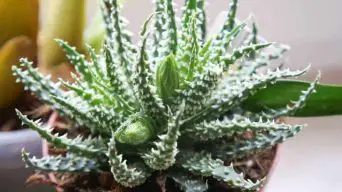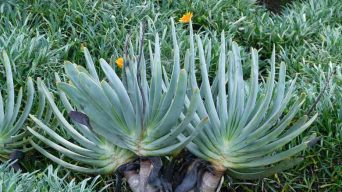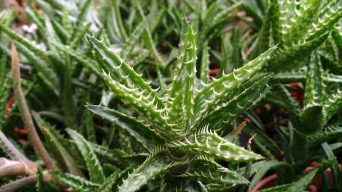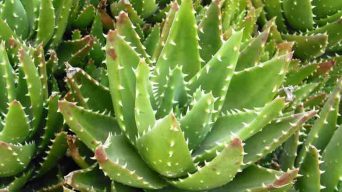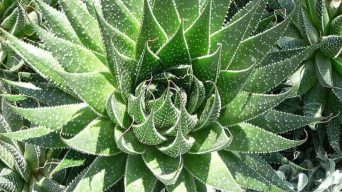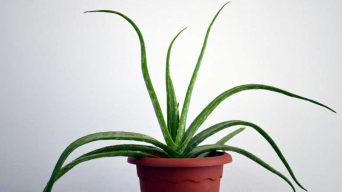Aloe ciliaris is a succulent plant known for its vibrant green leaves and how it blooms once in a while.
This plant can grow quite large, so it’s essential to know how to take care of it properly.
This guide will teach you how to take care of the Aloe ciliaris succulent and the best way to propagate new plants from it!
Overview
| Family: | Asphodelaceae |
| Genus: | Aloiampelos |
| Botanical Name: | Aloiampelos ciliaris |
| Synonyms: | Aloe ciliaris |
| Common Names: | Common Climbing Aloe or Climbing Aloe |
| Origin: | South Africa |
| USDA Hardiness Zones: | 9b – 11b |
| Size: | 8 to 12 feet (2 to 4 meters) in height |
| Sun Exposure: | Full sun to partial shade |
| Water Needs: | Water thoroughly but infrequently |
| Soil Type: | Well-draining soil |
| Temperature: | 68° – 80° F (20 – 27°C) during the day and nights of 50° – 70° F (18-21°C) |
| Humidity Levels: | 40% |
Aloiampelos ciliaris, formerly classified as Aloe ciliaris, is a fast-growing succulent from the Asphodelaceae family, native to South Africa.
Aloe ciliaris is a climbing aloe that produces thin green stems and leaves with hairy margins, which are recurved into a hook-like shape.
This Aloiampelos species is a tall succulent that produces large orange-red flowers from November to April.
The average Aloe ciliaris succulent plant will grow up to 8 to 12 feet (2 to 4 meters) in height.
This Aloe plant is also commonly known as:
- Common Climbing Aloe
- Climbing Aloe
- Fringe-leaved Aloe
How To Care for Aloe Ciliaris
Aloe ciliaris care doesn’t have to be complicated; you just need to know what you’re doing.
Below you’ll find the essential information you need to know about caring for Aloiampelos ciliaris.
Sun Exposure & Light Requirements
The Aloe ciliaris succulents thrive in full sun to partial shade.
Indoors, you can place your plants near a southern or southwest-facing window with plenty of bright light.
The Aloes need lots of sunlight for their health and happiness! The more time they spend outside on sunny days, the better.
Outdoors, provide them light shade during the hottest parts of the day when you are able.
Aloe ciliaris plants need at least six hours of sunlight each day, but more is better! Just be careful not to leave them outside for too long on the hotter days.
Watering Requirements
The Aloe ciliaris succulent plant is a desert-dwelling plant. As such, you need to water them about once a week, allow the soil to dry out before you decide it’s time for some more water, and avoid overwatering your plants.
A simple test you can do to determine if you should give your Aloes another drink of water or not by checking their potting mix.
Stick your finger into the dirt about an inch down; if you feel moisture, don’t add any more yet!
The easiest way to tell when your Aloes are thirsty again is by looking at the leaves – they will start to get a bit droopy, and you can feel the leaves are drier.
When you water this Aloe species, you should constantly water deeply and allow the potting mix to become wet before you stop watering.
The top inch or two of soil will dry out within a day if you’re doing things right – so don’t worry too much about giving your plants more than they want!
Soil Requirements
Aloe ciliaris succulents need a well-draining soil as a cactus and succulent soil mix.
They are sensitive to water, so you should avoid planting them in clay and heavy soils that take a long time to dry.
You can find potting mixes specifically made for succulents or cacti plants that have good drainage, as these have the right texture for your Aloe.
A good potting mix should have sand, loamy soil, and a bit of perlite (or you can use pumice or gravel).
Temperature and Humidity
The Aloe ciliaris succulent plant needs a temperature range of 68° – 80° Fahrenheit (20 – 27°C) during the day and nights of 50° – 70° Fahrenheit (18-21 °C).
This particular succulent can tolerate more heat than you would think. You can even let it sit outside in partial sun if you don’t live somewhere too cold.
The Climbing Aloe needs around 40% relative humidity to thrive.
You can add humidity to the air by placing pebbles in a water dish or using an evaporative cooler such as a humidifier.
If you live in a very dry place, you may need to add water more often than you would with other succulents.
Fertilizing
The Aloe ciliaris does not typically need fertilizer.
However, you may fertilize in the growing season with a diluted fertilizer at half strength to promote healthy growth.
If you decide to fertilize, use the correct type of fertilizer.
You mustn’t use a general-purpose plant food with the Climbing Aloe, as it could burn the leaves and kill your succulent plant.
It is also essential to feed your plant sparingly because the excess nutrients may end up hurting its health instead of improving it.
Potting and Repotting
When caring for an Aloe ciliaris, you must repot it, but only when necessary.
If you notice your plant getting too big or the roots circling and outgrowing the pot, you know that you need to change its container.
You also want to be careful not to overpot a succulent as this can cause problems with overwatering.
When you repot it, use only a pot one or two sizes larger than the previous container.
If you want your potted plant to grow at a reasonable height for its space, then choose a wide and shallow container when possible so that the roots will have more room to spread.
Pruning
You will want to prune the plant periodically, but you should not do it too aggressively.
You may need to cut back some old stems or leaves that are dead and gone soft.
The fleshy leaves grow at random intervals, so you don’t have to worry about cutting them all off at once to get them to grow neat and orderly.
Pruning the plant in early spring gives it enough time to regrow during the active growing season and helps to keep it from looking leggy.
Pests and Diseases
Aloe ciliaris plants can be affected by a variety of pests and diseases. Some common ones are scale, aphids, mealybugs, root rot, and powdery mildew.
Scale
Scale is caused by the sucking action of these tiny insects that secrete an oily substance known as honeydew on lower leaves.
Honeydew causes a black sooty mold to form, and your plant will start to wilt.
To treat scale, you can use neem oil or soap mixed with alcohol.
Aphids
Aphids are soft-bodied insects that you will notice sucking your plant juices.
They also spread diseases and can cause the leaves of your Climbing Aloe to curl up or become distorted.
To treat an infestation, you should use neem oil or soap mixed with alcohol on the affected plant parts.
Mealybugs
Mealybugs are tiny insects you can see with the naked eye that suck plant juices.
They grow quickly, and you will find them on leaves or stems in large numbers, making your Aloe ciliaris a sticky mess.
To treat mealybugs, you should mix neem oil with a water solution to spray all of your succulents.
Root Rot
Root rot is caused by prolonged exposure to water or moisture. You will notice your Climbing Aloe turning a brownish color.
It also causes the leaves at the plant’s top to wilt and falls off.
To treat root rot, you should prune away all infected parts with a sterilized blade such as a sharp knife. You should also change the potting mix if necessary.
Powdery Mildew
Powdery mildew is a fungus that starts from spores carried on plant debris, dirt, and air to your Aloiampelos ciliaris plants.
You will notice white or gray powder forming on both surfaces of your leaves, which can cause leaf spots that become brown or black.
To treat, you should use neem oil or soap mixed with alcohol solution twice a day for three weeks to kill the fungus causing this infection.
How to Care for Aloe Ciliaris in Winter
If you live in a mild climate with no frost, you can grow your Aloe ciliaris succulent plants outdoors throughout the year.
But people living in areas with frost must bring these plants indoors before the first freeze.
The best time to bring your succulent inside is when the temperature starts dipping below 40° Fahrenheit (above zero degrees Celsius).
Once you bring your plants indoors, keep them in a bright window and water them only when the soil is dry.
How To Propagate Aloe Ciliaris
Aloe ciliaris succulent plants are propagated by cuttings, offsets, or seeds.
Cuttings
Aloiampelos ciliaris plants can be propagated by cuttings.
You need to remove a leaf or stem cuttings to propagate the plant. Allow the cuttings to callous for a few days and plant them in well-draining soil.
Water the Climbing Aloe plants after you have planted your cuttings.
The cutting should root in about six weeks, and you can then move the new plant to a more permanent location.
Offsets
Aloiampelos ciliaris plants can also be propagated by offsets.
Offsets are tiny plants that grow from the base of the Climbing Aloe.
You should carefully remove the offset from the mother plant to propagate by offsets.
Then you can plant it in well-draining soil, give them plenty of sun or light, and keep the soil moist but not wet.
The offsets should start to develop roots after a few weeks, and you should be able to transplant them.
Seeds
The Aloiampelos ciliaris can also be propagated from seeds.
You should allow the seed to callous for a few days before you sow it in well-draining soil, keep the soil moist but not wet, and give plenty of sun or light.
The seeds should start germinating after a few months, and you should be able to transplant them into individual pots.
The Climbing Aloe should grow the following year, and you can begin your propagation process again.
Is the Aloe Ciliaris Toxic?
Aloe ciliaris is not toxic.
It does contain some natural components that can irritate your mouth or stomach if you swallow it. Still, you won’t die from Aloiampelos ciliaris ingestion.
Final Thoughts
Aloe ciliaris, or Aloiampelos ciliaris, is a relatively easy succulent plant to take care of. It’s easy and fun for beginners or those with experience!
Just be sure you are aware of the light and watering needs and the temperature requirements for your Climbing Aloe plants to keep them healthy!


